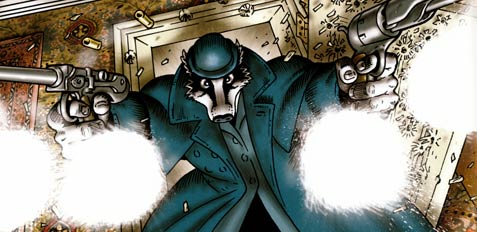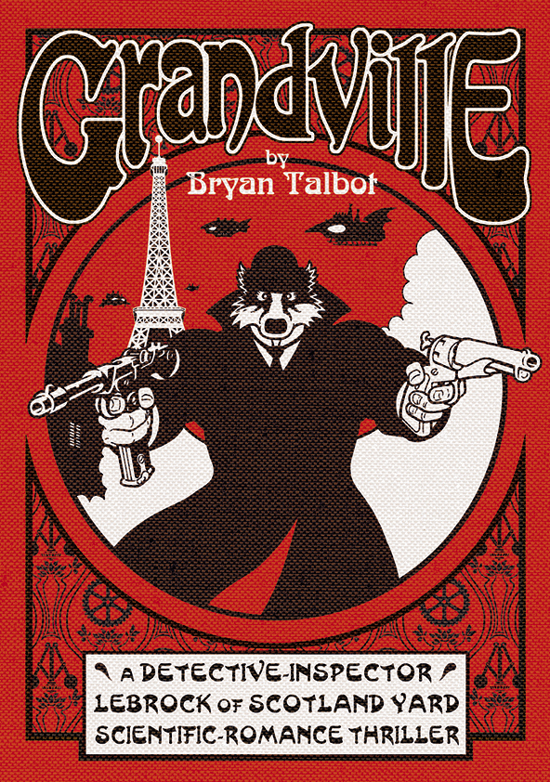Grandville
Reviewed by Ian Moore 23-Feb-11
This 2009 graphic novel seems to have done sufficiently well to produce a recent sequel, Grandville Mon Amour. It is a rather odd beast, presenting us with a story set in a world where France won the Napoleonic Wars and still rules the continent in the early 21st century, with Britain having been granted independence only a few decades earlier. The story is mostly set in Paris, now renamed Grandville (hence the title), now a kind of steampunk theme park with excitingly retro-futuristic technology.
This 2009 graphic novel seems to have done sufficiently well to produce a recent sequel, Grandville Mon Amour (FA review). It is a rather odd beast, presenting us with a story set in a world where France won the Napoleonic Wars and still rules the continent in the early 21st century, with Britain having been granted independence only a few decades earlier. The story is mostly set in Paris, now renamed Grandville (hence the title), now a kind of steampunk theme park with excitingly retro-futuristic technology. And the main characters are all anthropomorphic animals – basically people with animal heads. The main character is Detective Inspector LeBrock (a badger, obviously), a British policeman who travels to Grandville to investigate the murder in England of a British diplomat who had been based there.
This book is formatted not unlike a French comic book, with a much larger page size than one gets with US comics. It also seems like roughly the same length as one of those sophisticated continental titles, and the narrative has something of the boundless adventure of Hergé’s Tintin. The book has further hints to continental comics in some little nods to such things (which unfortunately went largely over my insular Anglophone head). Talbot’s art, however, stays largely away from the classic clear-line style of continental comics, with a much more lush colour palette and a generally more grottily realistic approach to drawing (to the extent that a comic with talking animals and steam-powered robots can look realistic, obviously). The cover, on the other hand, has an almost Art Nouveau look to it, something of a contrast with the low-rent adventures taking place inside.
Grandville‘s narrative cracks along, beginning with a relentless chase and moving from one set piece to another. But the plotting seems a bit slight – in investigating the diplomat’s murder, LeBrock discovers rapidly that he was actually a spy (of course), and then comes to realise that the spy was about to blow the lid on a French conspiracy that had perpetrated a 9-11 style outrage and blamed it on British anarchists. However, the conspiracy was so wafer-thin that it was amazing that no one had previously figured out what was going on.
 Grandville also has some odd logical inconsistencies, like the central question of just how a British policeman (sorry, policebadger) is able to carry on an investigation in a foreign country. It also seems a bit bizarre that he escapes being hauled in by the local cops, given the trail of corpses he leaves behind as he pursues his investigations. And that is another unappealing feature of the book – LeBrock is basically a maniacal thug who butchers his way through his enemies and is quite happy to torture suspects to death to extract information. Now, in a title with a satirical intent (e.g. Judge Dredd) it would make sense to have a central cop character presented as some kind of crypto-fascist, but that does not really work here – Talbot seems to be presenting LeBrock as an unambiguously heroic figure and not as a brutal metaphor for actual Britain’s thuggish cops.
Grandville also has some odd logical inconsistencies, like the central question of just how a British policeman (sorry, policebadger) is able to carry on an investigation in a foreign country. It also seems a bit bizarre that he escapes being hauled in by the local cops, given the trail of corpses he leaves behind as he pursues his investigations. And that is another unappealing feature of the book – LeBrock is basically a maniacal thug who butchers his way through his enemies and is quite happy to torture suspects to death to extract information. Now, in a title with a satirical intent (e.g. Judge Dredd) it would make sense to have a central cop character presented as some kind of crypto-fascist, but that does not really work here – Talbot seems to be presenting LeBrock as an unambiguously heroic figure and not as a brutal metaphor for actual Britain’s thuggish cops.
I was also a bit conflicted about the whole furry aspect of this book – does it really gain anything by not just having the characters being normal people instead of anthropomorphic animals? Of course, to fans of furry fiction presenting a parade of anthropomorphic animals requires no excuse, but general readers might find this a bit more eyebrow-raising. Talbot has done steampunk strips before (most notably Luther Arkwright and its superior sequel, Heart of Empire, and also the Gothic Empire sections of Nemesis), so maybe the animal aspect is his way of bringing something new to the table. His introduction also mentions that the work is inspired by the work of a 19th century French caricaturist who worked under the name J.J. Grandville, who may also have drawn people as anthropomorphic animals. But I do not really get the point behind this furry stuff – I like the cuteness of the animal faces, but having them engage in all kinds of sordid activity is not so entertaining.
On the other hand, Talbot does squeeze a couple of nice jokes or references out of the furry setting. One of the most striking is the appearance of what are basically people (not anthropomorphic animals), drawn for once in a style straightforwardly evocative of Tintin. LeBrock tells his sidekick that they are a hairless breed of chimpanzee from the town of Angoulême – no doubt an in-joke for people more au-fait with francophone comics. An actually moving moment comes when LeBrock encounters an opium-addicted white dog called Snowy Milou. Named obviously for Tintin’s dog (combining his English and French names), this character babbles of his opiated dreams, which are clearly references to his adventures with Tintin. It is quite affecting, and a world away from the jokey referencing of other people’s characters seen in Alan Moore and Kevin O’Neill’s League of Extraordinary Gentlemen.
So, there are good things about this book. It is hard to reach an overall verdict on it – its flaws seem very obvious to me, but I did enjoy reading it and look forward to checking out the sequel. Maybe better plotting and a toning down of the main character’s thuggish tendencies could combine with a foregrounding of the poignancy seen in the Snowy Milou sequence to make the sequel a far superior work.
Tags: Bryan Talbot, Grandville, Jonathan Cape
I imagine the Angoulême reference is to the huge comic convention held there – it also houses France’s lovely national comics museum. I was there for its opening ceremony, around 20 years back.
Interesting to read your review of the sequel.
LoEG was only really jokey in the first volume. Or rather, that’s where the joke was pretty much the whole substance of the enterprise. As it’s gone on the juxtapositions have increasingly tended to be both affecting and thought-provoking, as well as building towards a sort of unified field theory of fiction.
(Well, except the Wodehouse pastiche. But nobody can do Wodehouse pastiche well)
I wrote a Wodehouse pastiche once that I was very pleased with! It was a response to all those idiotic letters in Marvel comics saying that if Shakespeare were alive now he’d be writing superhero comics. I wrote a series of short superhero prose pieces in the style of great writers (including a Shakespeare Avengers, more or less the Macbeth banquet scene with Cap seeing Bucky’s ghost, and a Hemingway Hulk), one of which was a Wodehouse scene where Batman is talking to Alfred, featuring Alfred making comments about his costume and late hours, and ending with Batman admitting that he had accidentally become engaged to Catwoman.
Is that posted anywhere? It sounds worth a read! (What about the FF in the Negative Zone to the style of William Burroughs? “How can we ever get back to the world of normative sentence structure???”)
No. I might try to find it sometime – it was in an old BAPAzine, probably in the ’80s.
Yours may be the one to prove me wrong, but I’ve read about a dozen, mostly by writers I really like, and none of them has convinced me. I think because Wodehouse’s mixture of aptitudes (his facility with language) and weird blank spots (the utter inability to conceive of genuine evil, say, or sex) was pretty much idiot savant stuff. And emulating such a truly alien consciousness while also making it all seem bright and breezy is tricky enough even before bringing in outside elements (in Moore’s case, the very opposite components of work by the equally strange Lovecraft).
No, I am not going to make any big claims for mine. Wodehouse is one of my three favourite novelists ever, and my piece was just using his style to make an amusing combination with Batman, who is obviously the opposite of how you describe PGW’s blank spots.
Though you could make a case that his resolute, deranged refusal to kill – even to the extent of at least twice seeking extreme medical intervention to save the Joker from damage inflicted by others – represents something not a million miles from Wodehouse’s pathological sunniness.
(I love Wodehouse’s books too, don’t get me wrong – but psychologically he terrifies me)